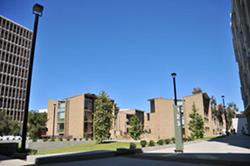
by Shane Henson — May 4, 2012—The University of California at San Diego is celebrating two firsts that demonstrate its commitment to sustainability and its forward-thinking mindset to be more green. The flagship school’s Charles David Keeling Apartments were recently awarded LEED-NC (Leadership in Energy and Environmental Design for New Construction) Platinum certification from the United States Green Building Council, making it the first LEED Platinum student housing in the University of California system. It is also the first new building at UC San Diego to receive a Platinum rating.
The LEED certification system provides independent, third-party verification that a building was designed and built using strategies aimed at achieving high performance in key areas of human and environmental health: sustainable site development, water savings, energy efficiency, materials selection and indoor environmental quality. Platinum is the highest LEED certification level that can be achieved.
Named in honor of Charles David Keeling, the American scientist whose research at Scripps Institute first alerted the world to the possibility of the human impact on global atmospheric carbon, the apartments employ a suite of tactics to address Southern California’s pressing environmental challenges of storm water management, water scarcity, and carbon emissions.
According to the university, the most significant reduction of energy comes from using natural cooling from ocean breezes instead of mechanical cooling. The effectiveness of the building’s shape and arrangement to capture prevailing winds was verified through computational fluid dynamics to analyze air movement, and wind tunnel testing was used to ensure that the window size and unit design would provide occupant comfort without using air conditioning.
Heating efficiencies are achieved by thermal mass, and by an innovative backwards constructed rainscreen and air barrier exterior wall that reduces heat loss and water vapor infiltration. Any necessary mechanical heating is provided by a localized arrangement of individually controlled radiant panels. Lighting energy demand is largely met by day lighting, and is complemented in public spaces with occupancy-controlled lighting systems. On-site renewable energy comes from a rooftop photovoltaic array. The PV system is the first at UC San Diego to be funded through San Diego Gas and Electric’s innovative lease program.
Water, a scarce resource in Southern California that requires significant energy to transport, is managed with a comprehensive strategy of conservation and reuse. Conservation measures include water-efficient landscaping and plumbing; and on-site wastewater recycling, a pilot project for the UC system, provides landscape irrigation water at grade and for the planted roof. Storm water flow into the Pacific Ocean is remediated with a system of landscape bioswales and retention basins that reduce storm water quantity, delay peak water flow, and control flooding in this region of the campus and with the added benefit of reducing erosion of fragile coastal scrub arroyos, a particularly threatened ecosystem.
The buildings provide housing for 516 students, and are constructed with highly crafted, cast-in-place concrete that is left exposed inside and out. They reinterpret the original 1960s campus architecture, which features repetitive sun control elements and a color palette tied to San Diego’s coastal climate. Industrial fiberglass grating was cleverly used for sunshades and railings for its durability in marine environments, and because it does not contribute to solar heat gain. The material selections carry the long-term benefit of lower maintenance and longer replacement intervals, resulting in reduced costs and associated energy for the school.




